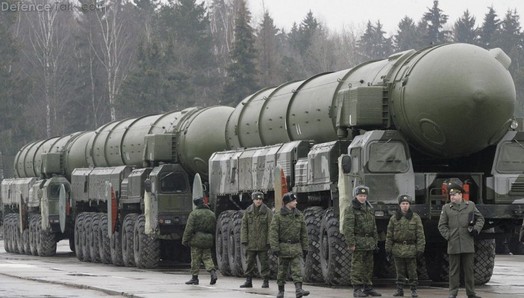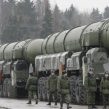
Russian Military Command Sees Need to Counter Growing Western Threat
Publication: Eurasia Daily Monitor Volume: 12 Issue: 23
By:

The continuing bloody fighting in eastern Ukraine and the deepening crisis in relations with the West has prompted the Russian military to alter its defense development plans. A financial and economic crisis, caused by a steep fall in oil prices and Western punitive sanctions, is forcing the Russian Ministry of Defense to rearrange its procurement and deployment priorities. According to Tatyana Shevtsova, deputy defense minister in charge defense ministry finances, “other government spending programs have been sequestered, but national defense spending is not, though many experts have been insisting there must be defense cuts too.” The Russian 2015 defense budget is set at 3.3 trillion rubles or 4.2 percent of GDP. At the current official exchange rate that equals some $50 billion, but a year ago it would have been $100 billion. Shevtsova insisted: cutting defense spending would be tantamount to treason. According to Shevtsova, “NATO [the North Atlantic Treaty Organization] is massing troops on Russian borders and developing new offensive weapons.” The West wants to curtail the Russian rearmament program, and those who call for defense cuts are abetting the West, she added (Kommersant, December 23).
NATO has reacted to the Ukrainian crisis with plans to create a joint rapid reaction (spearhead) force of over 5,000, intended to reassure former Eastern Bloc countries that they will not be abandoned in time of threat. Six new permanent command-and-control centers, with up to 100 staff officers each, including personnel from the United States, could be established in Central and Eastern Europe, from Estonia in the north to Bulgaria to the south (Lifenews.ru, January 28). This modest reorientation of NATO’s defense pasture will be surely interpreted by the Russian military as evidence of a mounting Western threat. The defense ministry will do its best to push back attempts to cut its spending; but the dollar equivalent of its budget has effectively been halved regardless.
Member of the Russian military and political leadership believe they are dealing with mounting threats, growing costs and dwindling resources. At a meeting last week in Moscow of Russia’s top brass—the defense ministry collegium—first deputy defense minister and the chief of the General Staff, Army-General Valery Gerasimov, promised: “Russia will not allow the US and NATO to gain military supremacy.” In the standoff with the West, Gerasimov stressed the need to concentrate resources on an urgent effort to dramatically increase the battle readiness and firepower of Russia’s strategic nuclear forces on land, sea and air. According to Gerasimov, the combat readiness of two newly built Borei-class strategic nuclear ballistic submarines, each armed with 20 new Bulava submarine-launched ballistic missiles (SLBM), will be upgraded. The two subs—Vladimir Monomakh and Alexander Nevsky—were previously officially designated as being in “active service” in the Pacific fleet, based in Kamchatka in Viluchynsk harbor. Gerasimov announced that, this year, the Vladimir Monomakh and Alexander Nevsky will be designated as operating under “permanent readiness.” This will bring the number of combat-ready Borei-class subs to three (Mil.ru, January 30).
Gerasimov also announced that four new regiments of land-based inter-continental ballistic missiles (ICBM) will be designated as “permanent readiness” units in 2015. A typical land-based Strategic Rocket Forces (RVSN) regiment consists of ten ICBMs, though the number may vary. Gerasimov announced plans to procure in 2015 “more than” 50 new ICBMs. The general staff chief also declared a highly ambitious goal to increase to 80 percent the battle-readiness of Russia’s long-range bomber force (Dalnaya Aviatsiya—DA) (Mil.ru, January 30). An 80-percent Air Force battle-readiness level is hard to achieve and even harder to sustain over long periods of time. Officially, the DA command has some 64 strategic Tu-95MS Bear bombers, 16 Tu-160 Blackjack supersonic swing-wing bombers and some 150 Tu-22M3 Backfire bombers. Almost all of these planes have been produced during the Cold War; the force has been considered mothballed and remains in a low battle-readiness condition. It is not clear whether Gerasimov implied only the enhanced readiness of the strategic Tu-95MS Bear and Tu-160 Blackjack heavy bombers, which carry long-range nuclear-tipped cruise missiles, or the Tu-22M3 Backfire fleet, as well. It is equally unclear what will be the exact number of bombers in the fleet, of which “80 percent” must be permanently ready to go. Recently, the Air Force commander, Colonel-General Victor Bondarev, told reporters: “In 2015, six Tu-160 Blackjack bombers will be modernized and the number of Tu-95MS bombers will reach 43” (RT, December 23). Apparently the Russian military has been cutting its official bomber list, while struggling to increase the actual battle-readiness of those left.
According to Gerasimov, the effort to increase the battle-readiness of Russia’s strategic nuclear forces, as well as “a coordinated increase of the fighting potential of the conventional forces, will prohibit the US and NATO from gaining a military advantage over Russia” (Mil.ru, January 30). Apparently, the Russian political and military leadership is seriously preparing for the possibility of an armed standoff with the West and is beefing up the country’s nuclear deterrent capability. A number of prominent Russians recently spoke about the risk of nuclear war between East and West. According to Igor Ivanov, a former Russian foreign minister and Security Council secretary: “The threat of a nuclear conflict is higher today than it was during the Cold War. In the absence of a political dialogue, with mutual mistrust reaching historical highs, the probability of unintended accidents, including those involving nuclear weapons, is getting more and more real” (The Moscow Times, January 26). Former Soviet president Mikhail Gorbachev, meanwhile, accused the US of “pulling [Russia] into a new Cold War” that “may become hot” (Interfax, January 29).
Of course, a lot of this nuclear war threat talk is intended to scare the West into concessions over the Ukrainian crisis in the best Cold War tradition of so-called “brinkmanship,” known in Russian as “balancing on the verge of war” (balansirovat na grani voyni). This tactic seems to be bearing fruit: French President Francois Hollande announced France is against Ukraine ever joining NATO, and specifically remarked that the statement was intended to appease the Russians “who are concerned” (Interfax, February 5). This week, Hollande and German Chancellor Angela Merkel are flying on a mission to Kyiv and Moscow to promote a new peace plan for Ukraine (Interfax, February 5). However, the result may end up resembling the French-brokered ceasefire agreement that ended the Russian intervention into Georgia in August 2008—a “frozen” conflict, a partitioned Ukraine, and an emboldened Russia brandishing nuclear weapons each time it wants something.




